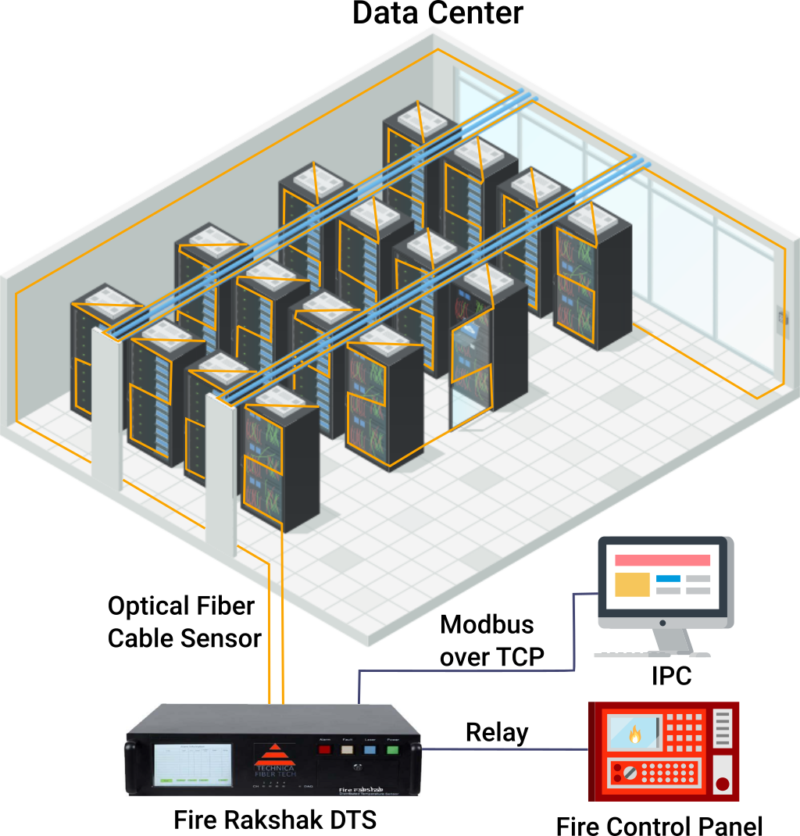Fire Rakshak Temperature Monitoring in Data Center
Fire Rakshak Temperature Monitoring in Data Center
Data centers are full of expensive computers and networking equipment that are very sensitive to environmental influences. Based on a Gartner study, the annual cost of a Wintel rack average is around $70,000 USD per year. This excludes the business cost of a rack. Power supply and environmental control are essential components for data center or server room system functionality, integrity, and safety. Risking losing business continuity or even your infrastructure due to environmental issues like temperature is not an option.
What is the impact of temperature on your systems? High-end systems have auto shutdown capabilities to safeguard against failures when the temperature is too high. But did you know that CPU level errors and as such errors in your applications can be temperature induced? On top of that heat will stress fan equipment even more. This reduces equipment lifetime expectance. All this affects your system’s availability and your business continuity.
Companies invest in high-end air conditioners (CRAC) and other equipment to keep these environments at their optimal operating states, but what if these devices fail, or even worse, are slowly failing. Temperatures start to rise slowly, equipment starts to heat up, and fans are spinning faster trying to keep everything cool until it reaches that crucial tolerance point where everything starts shutting down. Nobody has access to mission-critical applications, files, and emails. The company is losing money on just downtime alone, and in most cases, servers and other equipment can and will get damaged depending on when the fault was discovered. Replacing and bringing everything back up can get extremely expensive. A mistake often made is to only rely on monitoring the conditions at a room level and not at a rack level.
This can be foreseen and avoided with the use of Fiber Technica’s Fire Rakshak – DTS (Distributed Temperature Sensing) System. With the use of a Fire Rakshak, administrators can ensure uptime and continuous business operation. Fire Rakshak’s web interface provides real-time monitoring for data centers on remote PC and enables informed decision-making to optimize critical systems on demand and improve asset lifespans. Fire Rakashk’s software allows for real-time zonal temperature profiling, hot-spot detection, and alarm triggering, as well as data visualization including historical zonal temperature trends.
Why use Fire Rakshak for data center monitoring?
The majority of data centers aim for lower ambient temperatures, usually in compliance with the American Society of Heating, Refrigerating and Air-Conditioning Engineers (ASHRAE) recommended range of 18°C to 27°C. This range is evidently below the CPU point of no return; however, data center temperature in modern high-density facilities is hardly the same from rack to rack. Hot spots borne of airflow deficiencies and other disruptive conditions can result in isolated instances of critical equipment becoming at risk of overheating.
Data centers are full of expensive computers and networking equipment that are very sensitive to environmental influences. Based on a Gartner study, the annual cost of a Wintel rack average is around $70,000 USD per year. This excludes the business cost of a rack. Power supply and environmental control are essential components for data center or server room system functionality, integrity, and safety. Risking losing business continuity or even your infrastructure due to environmental issues like temperature is not an option.
What is the impact of temperature on your systems? High-end systems have auto shutdown capabilities to safeguard against failures when the temperature is too high. But did you know that CPU level errors and as such errors in your applications can be temperature induced? On top of that heat will stress fan equipment even more. This reduces equipment lifetime expectance. All this affects your system’s availability and your business continuity.
Companies invest in high-end air conditioners (CRAC) and other equipment to keep these environments at their optimal operating states, but what if these devices fail, or even worse, are slowly failing. Temperatures start to rise slowly, equipment starts to heat up, and fans are spinning faster trying to keep everything cool until it reaches that crucial tolerance point where everything starts shutting down. Nobody has access to mission-critical applications, files, and emails. The company is losing money on just downtime alone, and in most cases, servers and other equipment can and will get damaged depending on when the fault was discovered. Replacing and bringing everything back up can get extremely expensive. A mistake often made is to only rely on monitoring the conditions at a room level and not at a rack level.
This can be foreseen and avoided with the use of Fiber Technica’s Fire Rakshak – DTS (Distributed Temperature Sensing) System. With the use of a Fire Rakshak, administrators can ensure uptime and continuous business operation. Fire Rakshak’s web interface provides real-time monitoring for data centers on remote PC and enables informed decision-making to optimize critical systems on demand and improve asset lifespans. Fire Rakashk’s software allows for real-time zonal temperature profiling, hot-spot detection, and alarm triggering, as well as data visualization including historical zonal temperature trends.
Why use Fire Rakshak for data center monitoring?
The majority of data centers aim for lower ambient temperatures, usually in compliance with the American Society of Heating, Refrigerating and Air-Conditioning Engineers (ASHRAE) recommended range of 18°C to 27°C. This range is evidently below the CPU point of no return; however, data center temperature in modern high-density facilities is hardly the same from rack to rack. Hot spots borne of airflow deficiencies and other disruptive conditions can result in isolated instances of critical equipment becoming at risk of overheating.

ASHRAE recommends installing a minimum of six temperature sensors per rack. Three will go in the front (at the top middle and bottom) and three in the back in order to monitor air intake and exhaust temperatures. Instead of installing countless numbers of conventional sensors, the Fire Rakshak uses a single strand of optical fiber as a sensor which is a more economical, precise, and robust alternative. And it is highly recommended to use more than just six sensors per rack in order to create more precise temperature and airflow models for high-density data centeres operating at an ambient 27°C.
Why? The simple answer is that you can’t discover a hotspot if you can’t see it. Fire Rakshak will notify designated staff via SMS or email the second a safe temperature threshold is breached.
And again, the optical fiber in the Fire Rakshak functions as an array of linear sensors, and the more the sensors, the merrier. It is great to know that you will always have a real-time alerting system on your side. The data from our device with both fine spatial and temporal resolution allow data centers to accurately evaluate conductor temperature and heat transfer while providing key information for improving system efficiency and safety. By measuring thermal dissipation correlated with power consumption and capacity, data center power usage effectiveness (PUE) can also be improved.
Fire Rakshak enables facility managers to:
- Ensure uptime by monitoring racks for potential hot spots
- Save on cooling by confidently raising data center temperatures
- Improve data center availability by receiving environment alerts
- Make strategic decisions on cooling design and containment
- Set thresholds and alerts to monitor onsite or remote facilities

ASHRAE recommends installing a minimum of six temperature sensors per rack. Three will go in the front (at the top middle and bottom) and three in the back in order to monitor air intake and exhaust temperatures. Instead of installing countless numbers of conventional sensors, the Fire Rakshak uses a single strand of optical fiber as a sensor which is a more economical, precise, and robust alternative. And it is highly recommended to use more than just six sensors per rack in order to create more precise temperature and airflow models for high-density data centeres operating at an ambient 27°C.
Why? The simple answer is that you can’t discover a hotspot if you can’t see it. Fire Rakshak will notify designated staff via SMS or email the second a safe temperature threshold is breached.
And again, the optical fiber in the Fire Rakshak functions as an array of linear sensors, and the more the sensors, the merrier. It is great to know that you will always have a real-time alerting system on your side. The data from our device with both fine spatial and temporal resolution allow data centers to accurately evaluate conductor temperature and heat transfer while providing key information for improving system efficiency and safety. By measuring thermal dissipation correlated with power consumption and capacity, data center power usage effectiveness (PUE) can also be improved.
Fire Rakshak enables facility managers to:
- Ensure uptime by monitoring racks for potential hot spots
- Save on cooling by confidently raising data center temperatures
- Improve data center availability by receiving environment alerts
- Make strategic decisions on cooling design and containment
- Set thresholds and alerts to monitor onsite or remote facilities
Benifits

Preventing Downtime
The temperature is an important parameter for the equipment’s functioning. Computer systems are designed to work best in the ambient temperature range. This is achieved through an automated temperature monitoring system.
When cooling fails, hot air exhausted by the server becomes dominant. If the temperature is not maintained, downtime will happen. And downtime costs both time and money. Based on Gartner, data center downtime costs approximately $5,600 per minute or up to $540,000 per hour. With Technica Fiber Tech’s Fire Rakshak, administrators will be notified promptly. This allows them to take alternative actions to lower temperature and prevent downtime.
Automatic Alerts
Flexibility in the assignment of independent zonal temperature thresholds allows for customized alarm triggering, while the fine spatial and temporal resolution of Fire Rakshak‘s data enables quick fault detection and localization. The device sends alerts on changes in the temperature that is set. There is no need to manually check it from time to time to see if there’s a rise or drop in temperature. Additionally, after receiving the alert, administrators can quickly contact the personnel to act upon it.
Cost-efficiency
One unit of Fire Rakshak can monitor dozens of zones comprising kilometers of fiber installed throughout a data center; providing information on all critical systems simultaneously using a single instrument.
Keeping Records
The Fire Rakshak will automatically generate reports. The data will be kept as a record that can be accessed in the future. Significant decisions are affected by the records leaving no room for human error such as incorrect or lost records. Unlike manual recording, the monitoring system delivers data with little to no error.
Efficient system design
High-resolution temperature data sets make it possible to analyze system power consumption and heat dissipation with greater accuracy and precision than conventional point sensors. The data can help administrators decide where to put additional equipment. It is a critical decision as it increases hot airflow in the facility. They can also have insight on what layout to use to prevent disrupted airflow or mixing of hot and cold air. A monitoring system can work with a CDF Analysis to get a comprehensive vision of data center scaling.
Benifits

Preventing Downtime
The temperature is an important parameter for the equipment’s functioning. Computer systems are designed to work best in the ambient temperature range. This is achieved through an automated temperature monitoring system.
When cooling fails, hot air exhausted by the server becomes dominant. If the temperature is not maintained, downtime will happen. And downtime costs both time and money. Based on Gartner, data center downtime costs approximately $5,600 per minute or up to $540,000 per hour. With Technica Fiber Tech’s Fire Rakshak, administrators will be notified promptly. This allows them to take alternative actions to lower temperature and prevent downtime.
Automatic Alerts
Flexibility in the assignment of independent zonal temperature thresholds allows for customized alarm triggering, while the fine spatial and temporal resolution of Fire Rakshak‘s data enables quick fault detection and localization. The device sends alerts on changes in the temperature that is set. There is no need to manually check it from time to time to see if there’s a rise or drop in temperature. Additionally, after receiving the alert, administrators can quickly contact the personnel to act upon it.
Cost-efficiency
One unit of Fire Rakshak can monitor dozens of zones comprising kilometers of fiber installed throughout a data center; providing information on all critical systems simultaneously using a single instrument.
Keeping Records
The Fire Rakshak will automatically generate reports. The data will be kept as a record that can be accessed in the future. Significant decisions are affected by the records leaving no room for human error such as incorrect or lost records. Unlike manual recording, the monitoring system delivers data with little to no error.
Efficient system design
High-resolution temperature data sets make it possible to analyze system power consumption and heat dissipation with greater accuracy and precision than conventional point sensors. The data can help administrators decide where to put additional equipment. It is a critical decision as it increases hot airflow in the facility. They can also have insight on what layout to use to prevent disrupted airflow or mixing of hot and cold air. A monitoring system can work with a CDF Analysis to get a comprehensive vision of data center scaling.

